TVC + Content Production in Australia and NZ: State of the Industry 2021
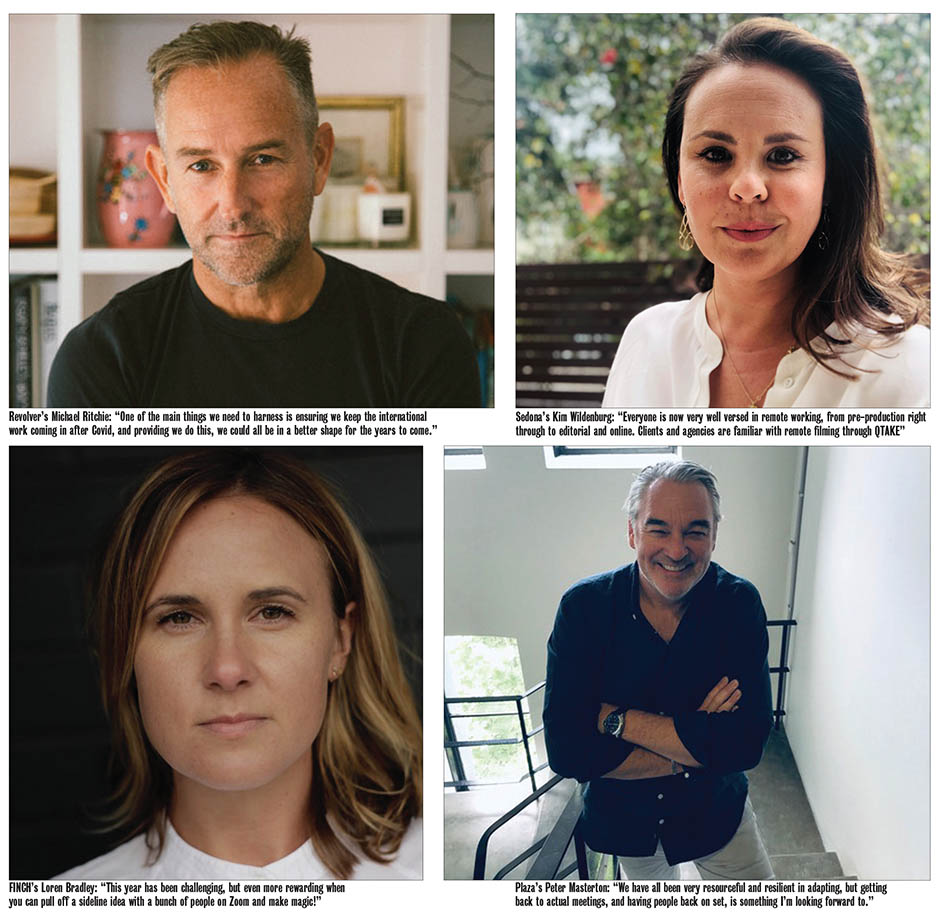
Producing remote shoots safely, adapting to changing interstate and international border closures along with working around cast and crew limitations, this year the country’s top production companies continued to flex their capacity for resourceful and inventive content creation. Campaign Brief catches up with key players to discover how they each navigated lockdown as the country begins to reopen.
This year many production companies faced similar challenges to last year as the pandemic continued to bring on uncertainty and a list of challenges that required a solution focussed attitude and a nimble and flexible approach.
According to Photoplay executive producer Oliver Lawrance, the second Covid lockdown felt hopeless at first, with no foreseeable light at the end of the tunnel: “The most difficult aspect was the endless Groundhog Day feeling,” Lawrance admits. “Filming continued in New South Wales but confidence took a hit in that first month. To keep filming, we needed a completely rigorous approach to Covid safety.”
The commercial film industry, he says, did incredibly well at keeping both crew and sets safe and the leadership and support provided by the CPC (Commercial Producer Council) was critical in navigating issues as they arose.
For Sedona managing director and executive producer, Kim Wildenburg, related challenges to last year included sourcing locations and securing council permits with many venues closed during lockdown. Limited retail access meant obtaining props and wardrobe supplies also required more time.
“Everyone is now very well versed in remote working, from pre-production right through to editorial and online,” she says. “Clients and agencies are familiar with remote filming through QTAKE, which makes things easier, and utilising platforms such as Clearview proved an excellent tool for real-time grading and online sessions.” The main difference from last year, she believes, has been the management of Covid testing and the isolating of crew, cast and any clients prior to recces and shoots. “This requires additional planning and time, and we’ve also been securing back up talent as an extra precaution.”
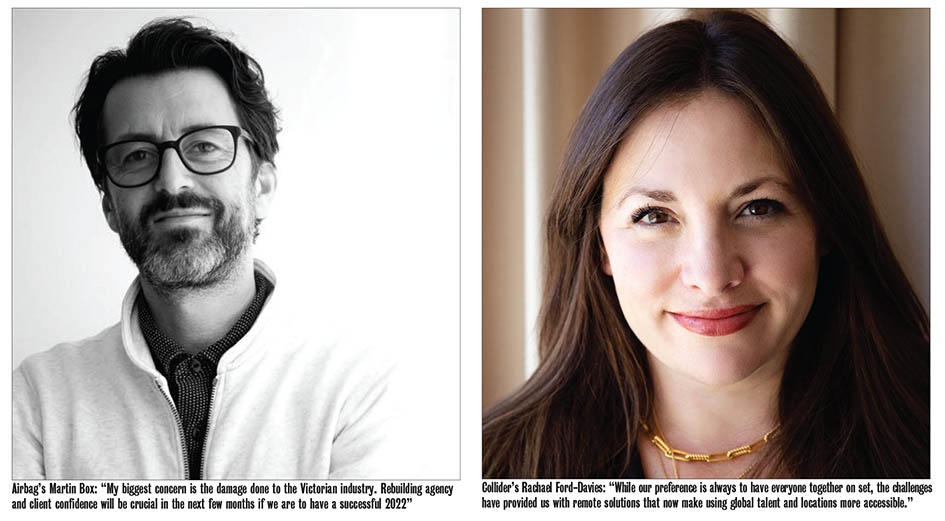
The Taxi Group managing director and executive producer Andrew Wareham reveals ‘remote production’ became last year’s new buzzword.
“Once everyone got a confident grasp of the remote way of working and refined that workflow process, it really did work exceedingly well,” he says, adding: “Covid aside, remote production is a great tool in circumnavigating logistical challenges (such as continuing to work with international clients and directors) and allowing production to continue. We’re finding some clients prefer it as a more convenient way of managing their own workloads so I definitely think elements of remote production are here to stay.”
One positive side effect, according to Collider executive producer Rachael Ford-Davies, is an increase in confidence with remote workflows in general. She says: “While our preference is always to have everyone together on set, the challenges have provided us with remote solutions that now make using global talent and locations more accessible.”
Revolver managing director, owner and partner, Michael Ritchie, says a knock on effect of the pandemic was the opportunity for the Australian production industry to re-present itself to the world. “We made a good impression but we also exposed the lack of depth in freelance crewed roles,” he explains. “I never would’ve guessed that this would be one of the most significant things we need to deal with. It’s been busy with both commercials and longform and it’s essential that we are bringing through new technicians in every department.”
According to Ritchie, this could be achieved through current key personnel, however he also thinks film schools would be wise to ensure they push to capture other key roles beyond direction and cinematography.
“Like I said last year, one of the main things we need to harness is ensuring we keep the international work coming in after Covid, and providing we do this, we could all be in a better shape for the years to come.”
Another issue is rising cost. Covid has momentarily turned Australia into a closed economy where a substantial amount of television and film projects are being made; meaning the impact on production costs is inevitably quite substantial.
Plaza executive producer Peter Masterton says: “I understand the same is true elsewhere in the world since the one thing that has been occurring everywhere is a massive boom in drama and film production.”
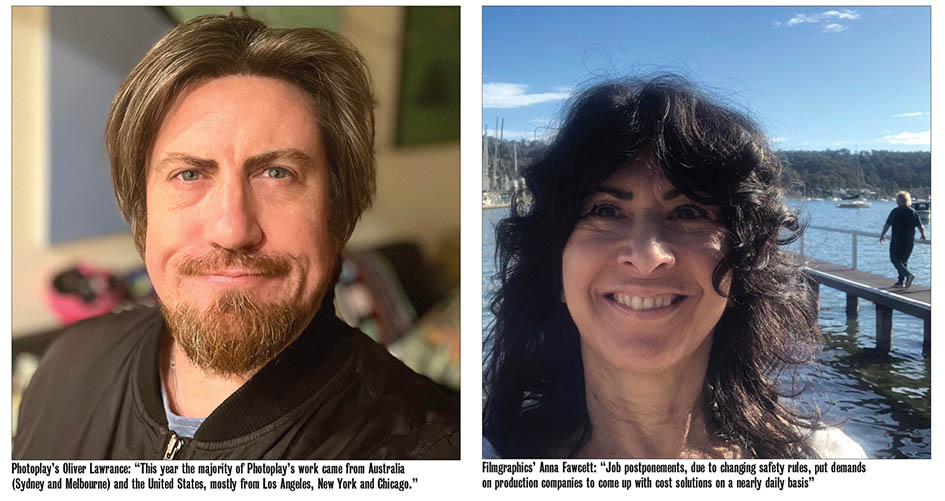
Filmgraphics executive producer Anna Fawcett points to job postponements, due to changing safety rules, putting demands on production companies to come up with cost solutions on a nearly daily basis. She says keeping everybody in the company safe, and respecting every person’s individual point of view, was also important this year.
“Due to lockdown, no overseas based directors could come to the country so Filmgraphics collaborated with the best freelance Australian directors we could find, and even when borders fully open up, it’s a practice we will continue.” Working from home, she adds, and not having to run a fulltime office, has also been a freeing experience.
Limehouse managing director and creative partner Duncan Harriss says the lack of personal connectivity, which usually allows a free flow of ideas, challenged creativity: “Remote production amped up but without the feeling of excitement that usually permeates a studio and infuses its vibe into the work. This was a challenge. We were fortunate in that our CGI team worked around the clock and still is.”
He says meeting new people to generate work and expand the company’s collection of freelance artists to put together the best team for every job was difficult. “That’s why we will be hosting regular Campaign Brief Creative Circle events and offering free desk space for creatives. Of course, when it’s possible again, anyone is welcome to introduce themselves to us over a beer.”
Sweetshop Australia executive producer Greg Fyson agrees, stating: “Production is a very social industry that thrives on human interaction and meaningful communication. The shorthand of working with trusted partners in the same room has been greatly missed and to be frank, has taken some of the joy out of what we do. I look forward to video conferencing being another tool in the belt rather than the primary tool for connection.”
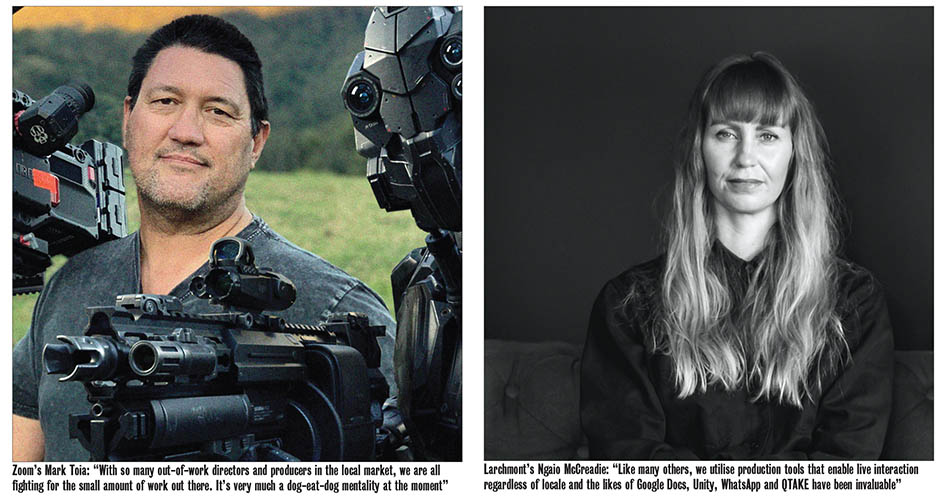
FINCH executive producer Loren Bradley says the rapid shift to remote work has emphasised the need for human connection and has highlighted how underrated transitional conversations in the workspace can be: “We can adopt collaboration tools and tech, but nothing can replace in-person discussion,” she says. “Our industry is excellent at building a creative community where we can bounce ideas off each other. This year has been challenging, but even more rewarding when you can pull off a sideline idea with a bunch of people on Zoom and make magic!”
Over at Flint, co-founder and executive producer Rachel Henderson believes shooting remotely will stay as a new way of working interstate, as will the Zoom call. She says this year Flint had to be far more considered and careful with the work the production company took on. “It was crucial we didn’t overstretch ourselves and we made sure we were able to deliver exceptional work in a Covid safe environment,” she says. “We put a lot of energy into attacking our briefs from the moment they arrived, sorting out every detail during the pre-production phase so we could arrive on shoot days knowing that all the potential problems had been solved. We had to get things right in pre-production because there was no room for change with locked-down shoots.”
Airbag head of production and executive producer Martin Box says the obvious fall out from the pandemic will take its toll in numerous ways but his biggest concern is the damage done to the Victorian industry. He says: “Rebuilding agency and client confidence will be crucial in the next few months if we are to have a successful 2022.”
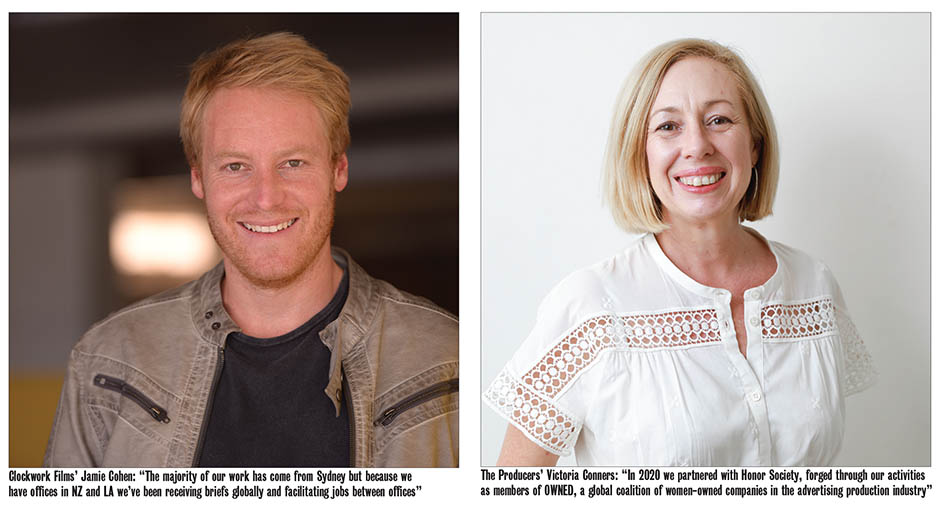
Airbag producer Megan Ayers says: “Initially, many jobs that were active with pressing deadlines, flipped to our internal vfx department, then came the growing acceptance of remote shooting. When overseas markets such as the US and Europe were overrun with Covid, we saw a spike in scripts from there, which has now returned to previous levels as their cases settle and vaccinations have gone up.”
Airbag executive producer Alex Tizzard adds: “I would say scheduling has been most affected, as we just need more time in pre-production – whether that’s for art department and wardrobe, or in post. Everyone has embraced remote working, and to be honest, I’ll take a Zoom briefing (where we can all see each others’ reactions) any day over a conference call.”
Economic uncertainty affected clients as much as it did production companies and Unlisted founder and managing director Katie Mackin says there was hesitancy in agency ad planning and spending. “While animation is easily adaptable to remote working, shooting for our mixed media films was exceptionally difficult this year,” she says. “Still, we made it work and are doubly proud of the results.”
According to Mackin, this year saw a number of positives for Unlisted. Most notably, working from home refined and strengthened the distributed work model that was already a part of the business.
“It’s given us the opportunity to try new tools and improve collaboration between our artists, directors, producers and staff. It’s also widened and diversified our talent pool. Whereas before we might have limited our search for producers, for example, to Melbourne or Sydney, we now seek the best person for the job, irrespective of location.” Unlisted’s core team works across six Australian cities and five countries and an important part of the company ethos is promoting a healthy work-life balance. “The shift to a fully distributed, global team is making that an attainable reality. It has allowed us to offer more flexible working hours and employ return to work mums – bringing talent to the team that might not have been an option if 9-5 hours in the studio were mandated.”
With offices in Brisbane, Sydney and Melbourne, the past 18 months accelerated the integration of The Producers’ three offices.
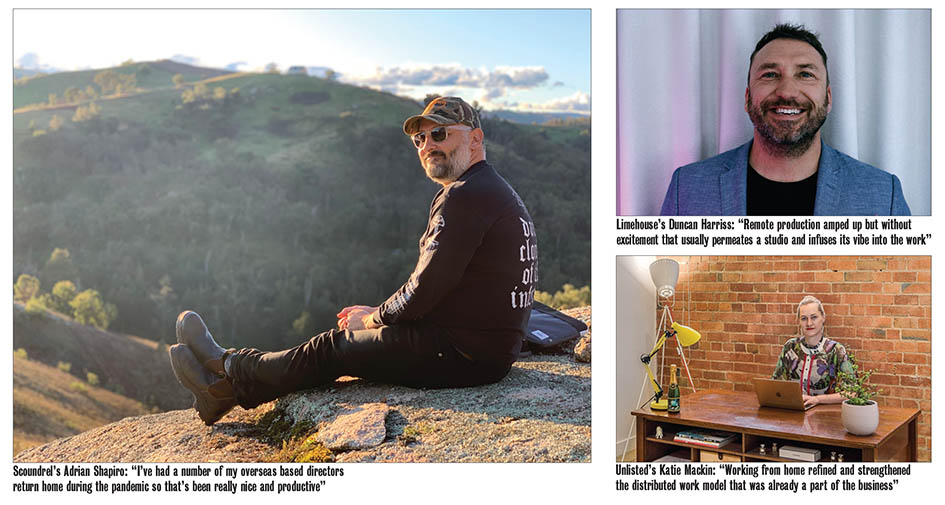
The Producers partner and executive producer Victoria Conners says: “We realised that production issues were often solved by chats in the office so last year we formalised those chats. Now production meetings and stand-ups include all the relevant teams across the offices. We now go through our projects one at a time and discuss details a lot more than before. It gives us more opportunities to lean on each other’s experience and going through our jobs at a more granular level allows us more opportunities to advise each other.”
The production company also broke down the geographical barriers with Melbourne production staff working on jobs in Queensland and NSW and vice versa. “It definitely built the culture across the offices, and it’s identified strengths in the team.”
Production house Larchmont launched in April during the pandemic and its founders essentially built a production solution that could adapt to the modern times.
Larchmont managing director and partner Ngaio McCreadie says: “Being small and independent means that we can work quickly and in a highly bespoke manner. Like many others, we utilise production tools that enable live interaction regardless of locale and the likes of Google Docs, Unity, WhatsApp and QTAKE have been invaluable.”
McCreadie adds that larger markets like Europe, the US and Asia are well accustomed to working regionally with less emphasis on needing to be in the same place at the same time. “It’s been nice to see this philosophy adapted in Australasia with fantastic creative results.”
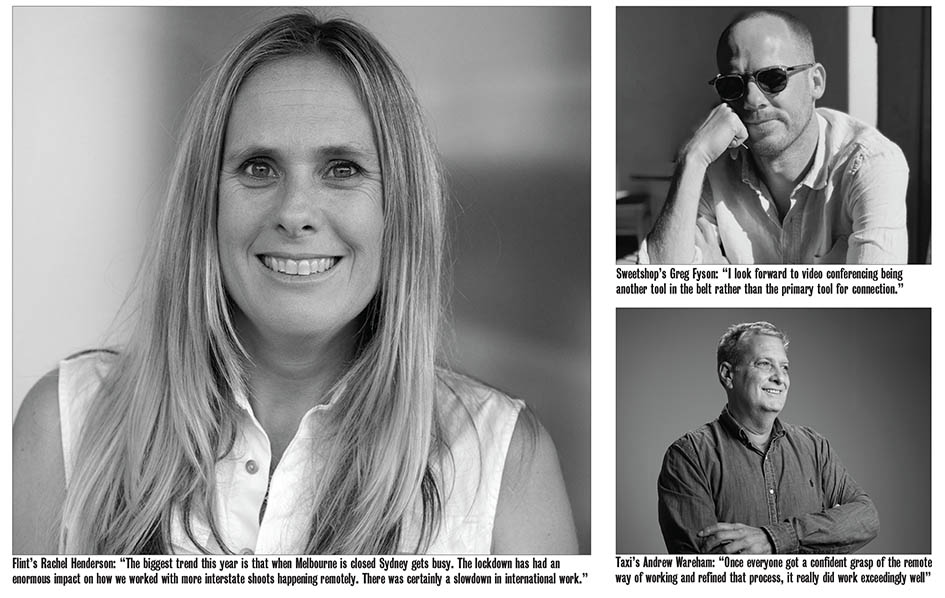
GLOBAL BRIEFS and LOCAL TALENT
This year the majority of Photoplay’s work came from Australia (Sydney and Melbourne) and the United States, mostly from Los Angeles, New York and Chicago. The production company also signed new talent, including director Imogen Grist to its Playtime roster. Says Lawrance: “I was blown away by Imogen’s Clypso music video when judging the Clipped Music Video Festival. It was so creatively original and the film craft was playful and perfectly executed. Her work has this infectious energy to it and I can’t wait to see what she does next.”
Photoplay also welcomed home senior producer and partner Florence Tourbier at the start of the year, after a prolonged stint in London. “Florence started Photo-play with Scott Otto Anderson and myself and it’s truly wonderful to have her wisdom and influence back in the day-to-day workings of our extended Photoplay family.”
Sedona saw mostly local briefs from NSW, Victoria and South Australia and took on new animation specialists, Le Cube and Golden Wolf.

